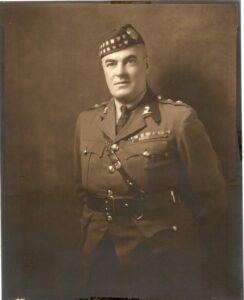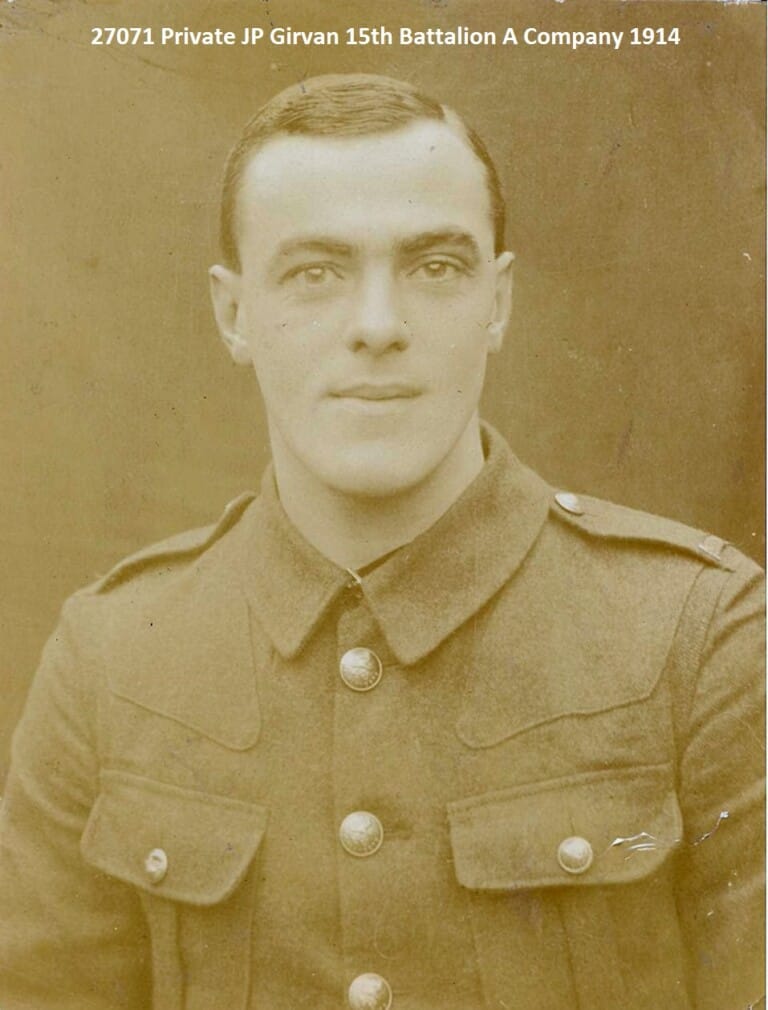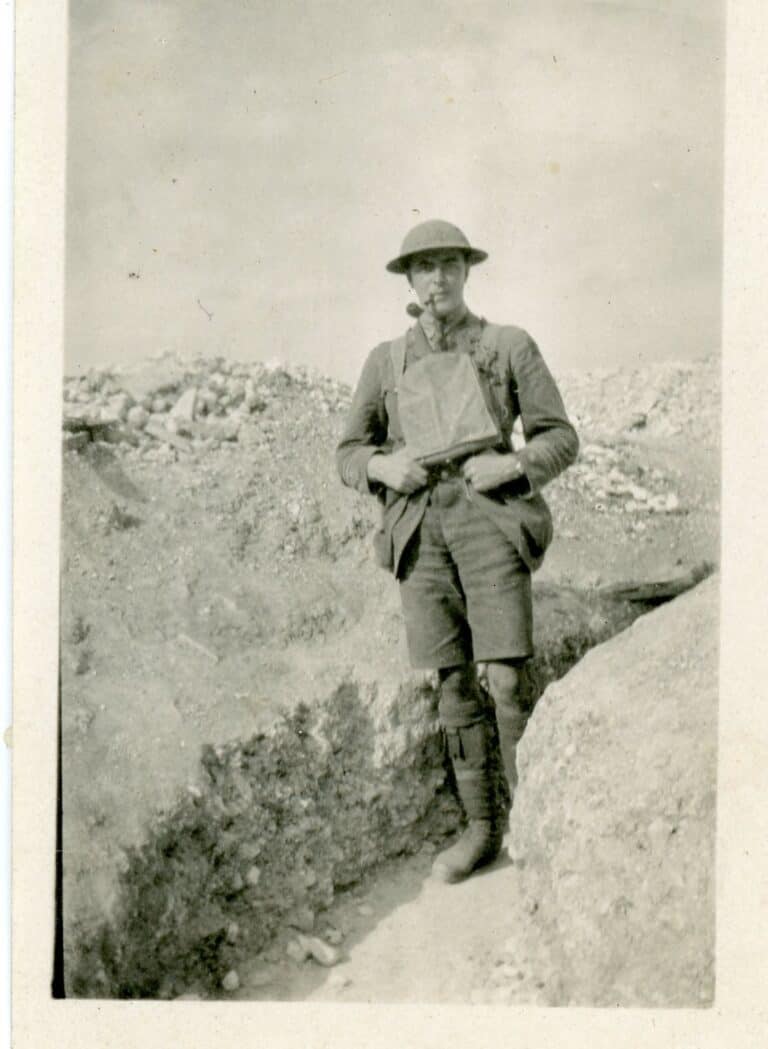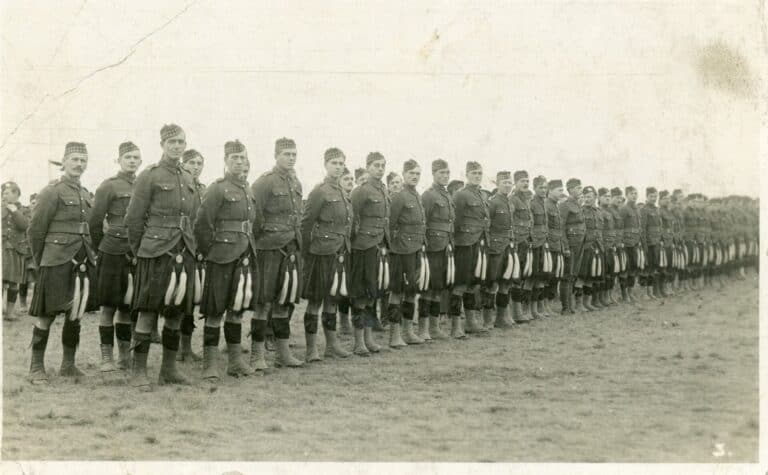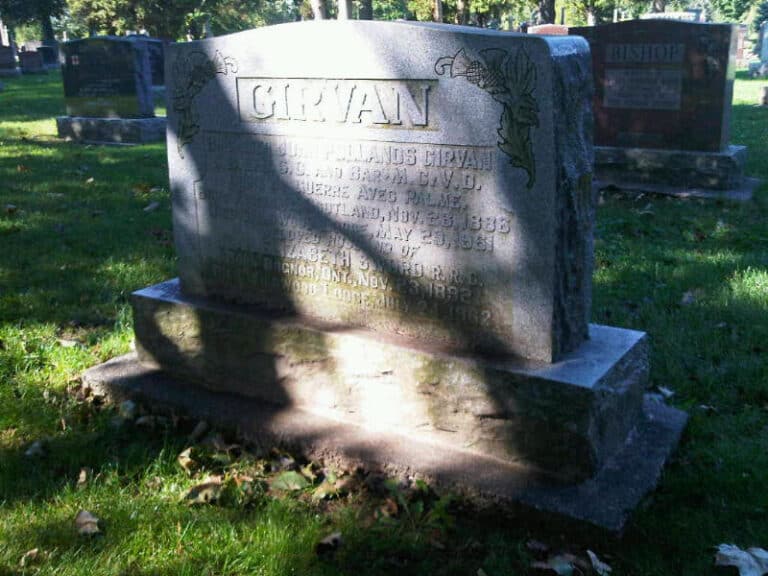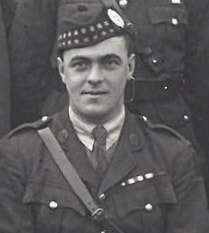Commanding Officer 15th Battalion 1918 (The Last 100 Days)
Commanding Officer 48th Highlanders of Canada 1932-1936
Commanding Officer 2nd Battalion 48th Highlanders of Canada 1940
Director of Military Training 1940-45 National Defence Headquarters
John ‘Jack’ Pollands Girvan was born born on 28 November 1887, at Kingarth, Argyll and Bute, Scotland. In 1907, he became a clerk in the Civil Service. He was a fine athlete, winning numerous championships as a member of the Argonaut rowing club.
He was raised in Toronto, worked as a postal clerk and was a multi championship rower. He joined the 15th Battalion as 27071 Private Girvan J.P
Girvan sailed on 3 October 1914, with the first contingent, arriving in England on 16 October 1916. The following week, they boarded S.S. Mount Temple, at Avonmouth, on 12 February 1915. After a very rough voyage with high seas, they arrived at St Nazaire, in France, on 15 February 1915. Two days later, they arrived at Hazebrouck in Belgium, moving into billets at Caestre the next day and into billets in Armentieres on 23 February 1915.
The 15th Battalion entered the trenches for the first time on 24 February 1915, suffering their first casualty on the night of the 27th. They entered the trenches at Rue Petillon, on 6 March 1915, pulling out three days later.
In April 1915, the Canadians moved to the Ypres area and took part in the battle of Kitchener’s Wood (Second Battle of Ypres). The 15th Battalion held the line against the German chlorine gas attack, but suffered heavy casualties. The battalion was at the apex of the Canadian position on 24 April. The 15th Battalion suffered the heaviest casualties of any Canadian unit, with over 647 casualties, being hit by the heaviest of the gas, and was overrun by the Germans. Girvan’s No. 1 Company, was on the extreme right flank of the Battalion’s three forward companies and was very lucky to have survived.
In the battle of Festubert, on 15 May 1915, the battalion again suffered heavy casualties. Girvan was promoted to be Sergeant, in the field, ‘A’ Company, 15th Battalion, on 11 June 1915. He was appointed to Temporary Commission, and posted to 15th Battalion on 26 September 1915; granted 5 days leave, 17 October 1915; granted 7 days leave, 5 January 1916; to be Captain, 27 April 1916; granted leave of absence from 25 May to 2 June 1916. On 3 June 1916 the Battalion conducted the first Canadian counter-attack of the war against Observatory Ridge, in opening stages of the battle of Mount Sorrel, again suffering heavy casualties.
Now a Major commanding No. 3 Company, he was wounded during the battle of Flers–Courcelette on 24 September 1916 (battle of the Somme), by a bullet wound which penetrated his right chest at the sternum, and travelled down and lodged in abdominal muscle. He was admitted to 2nd Red Cross Hospital, Rouen, on 27 September 1916, and to Yorkhill War Hospital, Glasgow, on 1 October 1916. A medical board further observed, “This Officer as a result of 20 months service in Flanders is debilitated and his nerves are shaken. Requires a prolonged rest.” He was discharged on 18 October 1916, but was declared unfit for service for three months and granted leave to Canada, 21 October 1916 to 21 January 1917.
Girvan returned to England in late March of 1917, and was appointed Acting Major on 28 April 1917. Then, awarded the Croix du Guerre, on 1 May 1917. Here he spent several months in Bramshott Camp, Hampshire, where his future wife Jean Sword was undergoing training at the camp hospital, and they undoubtedly spent some time together.
Following several months rest leave in Canada, he resumed his post with the 15th after the battle of Vimy Ridge and won the Military Cross at Hill 70 in August 1917. Major Maybin (a Sgt-Maj also commissioned from the ranks) had been temporarily Officer Commanding the 15th Bn since LCol Bent had been severely wounded by shrapnel during the battle of Amiens in August. After Lieutenant Colonel C. E. Bent sustained a serious shrapnel injury in August 1918, Girvan assumed command of the battalion.
Major Girvan assumed command as the Arras operations commenced. He led the Battalion at the Crow’s Nest, the Drocourt-Queant Line and the Canal du Nord operations of the Hundred Days and until the war’s end in November 1918. He was awarded the DSO for his leadership at the D-Q line.
He was in command of No. 1 Company leading the forward assault of the 15th Battalion during the battle of Hill 70 (15 – 16 Aug 1917), and was awarded the Military Cross for this action in which the 15th Battalion assaulted and captured Puits 14 and Bois Hugo as part of the Canadian Corps assault on Hill 70 near Lens, France. The battalion was in the first wave of the assault on the Corps’ exposed and vital left flank. Having secured all their objectives on the morning of 15 August 1917, the battalion defended its position for a day and half against numerous German counter attacks until it was relieved and withdrawn from the line.
On 23 August 1918, with the Commanding Officer Lieutenant-Colonel C. E. Bent severely wounded, Girvan took command as the Acting Commanding Officer. Upon the C.O.’s return, several times Girvan acted as C.O. while the commander was away. On 30 August 1918, he narrowly escaped death when the Battalion H.Q. dugout took a direct hit from a German artillery shell.
Girvan commanded the Battalion during the attack on the Canal du Nord on 27 September 1918. In the north, above Ecluse No 3 at Sains lès Marquion, the canal had been finished and it was filled with water. From there, to the south, as far as Inchy the foundations were only half completed .The 1st Canadian Division assaulted across the canal at Sains lès Marquion on the 27 September 1918. The 15th Battalion began its advance towards the canal at 0845 hours. German machine-gun fire from Keith Wood had prevented the Canadian Engineers from building more than one bridge. Under constant fire, the Highlanders dashed across the canal and then the Agache River by making a plank bridge and the Companies spread out, taking different routes northwards between the canal and the main road. No 3 Company advanced just to the west of Keith Wood while No 2 Company remained closer to the canal and entered Marquion on its western side near the bridge destroyed by the Germans. A bitter struggle began for the streets with the German defenders fighting for every house. By 1330 hours, although Marquion had been taken, the attack was now behind schedule and the Highlanders were forced to continue on to Sauchy without artillery support. During the day the 15th Battalion captured 300 prisoners but at a cost of 153 casualties.
Following the war he returned to the Post Office rising through its ranks to become Assistant Postal Director. Girvan remained with the 48th Highlanders of Canada post war. He commanded the regiment from 1932 to 1936, and once again, as C.O. of the 2nd Home Battalion of the 48th Highlanders, in the Second World War. In 1940, he was appointed C.O. of the 1st Training Centre, at Camp Borden in England. Lastly, in 1943, he was promoted to Brigadier, and appointed to be Director of Military Training in Ottawa. In conclusion, for his Second World War service, he was awarded the Commander of the Order of the British Empire.
Girvan died in Georgetown ON in May 1961 and is buried there in Greenwood Cemetery.

